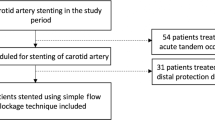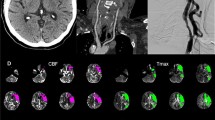Abstract
Purpose
To evaluate the feasibility and safety of endovascular recanalization for symptomatic subacute and chronic internal carotid artery occlusion (ICAO); to propose a newly modified radiographic classification of ICAO that can rigorously identify suitable candidates for endovascular ICAO treatment.
Methods
We included 42 consecutive patients who had ICAO with ischaemic symptoms refractory to medical therapy. We examined the symptomatology, complications, follow-up results and radiographic images of ICAO receiving attempted endovascular treatment. We attempted to stratify all radiographic images into categories based on morphological occlusion patterns, occlusion segments and distal ICA reconstitution on digital subtraction angiography (DSA).
Results
Four types (A–D) of radiographic ICAO were identified. We redefined type B as having a tapered stump but no distal lumen. The rate of successful recanalization was 83.33% (35/42 ICAOs; type A, 18/20; type B, 7/10; type C, 10/11; type D, 0/1). The perioperative complication rate was 11.90% (5/42), including 3 asymptomatic distal embolisms, 1 symptomatic cerebral infarction and 1 asymptomatic carotid artery dissection. None of these technique-related complications led to severe neurological damage or death. Modified Rankin Scale (mRS) scores after 1–20 months of follow-up were significantly decreased in successfully revascularized patients (P < 0.001). There was no significant change in mRS scores in the 7 patients in whom recanalization failed (P > 0.05).
Conclusions
Endovascular recanalization seems to achieve technical success and clinical improvement for symptomatic subacute and chronic ICAO. Additionally, our newly modified radiographic classification of ICAO may be valuable in assessing the technical feasibility and safety of procedures in symptomatic ICAO patients.




Similar content being viewed by others
References
Malhotra K, Goyal N, Tsivgoulis G (2017) Internal carotid artery occlusion: pathophysiology, diagnosis, and management. Curr Atheroscler Rep 19(10):41. https://doi.org/10.1007/s11883-017-0677-7
Persoon S, Luitse MJ, de Borst GJ, van der Zwan A, Algra A, Kappelle LJ, Klijn CJ (2011) Symptomatic internal carotid artery occlusion: a long-term follow-up study. J Neurol Neurosurg Psychiatry 82(5):521–526. https://doi.org/10.1136/jnnp.2010.208330
Persoon S, Klijn CJ, Algra A, Kappelle LJ (2009) Bilateral carotid artery occlusion with transient or moderately disabling ischaemic stroke: clinical features and long-term outcome. J Neurol 256(10):1728–1735. https://doi.org/10.1007/s00415-009-5194-3
Lin MS, Lin LC, Li HY, Lin CH, Chao CC, Hsu CN, Lin YH, Chen SC, Wu YW, Kao HL (2008) Procedural safety and potential vascular complication of endovascular recanalization for chronic cervical internal carotid artery occlusion. Circ Cardiovasc Interv 1(2):119–125. https://doi.org/10.1161/circinterventions.108.772350
Fluri F, Engelter S, Lyrer P (2010) Extracranial-intracranial arterial bypass surgery for occlusive carotid artery disease. Cochrane Database Syst Rev (2):Cd005953. https://doi.org/10.1002/14651858.CD005953.pub2
Grubb RL Jr, Powers WJ, Clarke WR, Videen TO, Adams HP Jr, Derdeyn CP (2013) Surgical results of the carotid occlusion surgery study. J Neurosurg 118(1):25–33. https://doi.org/10.3171/2012.9.jns12551
Powers WJ, Clarke WR, Grubb RL Jr, Videen TO, Adams HP Jr, Derdeyn CP (2011) Extracranial-intracranial bypass surgery for stroke prevention in hemodynamic cerebral ischemia: the carotid occlusion surgery study randomized trial. Jama 306(18):1983–1992. https://doi.org/10.1001/jama.2011.1610
Chen K, Hou X, Zhou Z, Li G, Liu Q, Gui L, Hu J, Shi S (2017) The efficacy and safety of endovascular recanalization of occluded large cerebral arteries during the subacute phase of cerebral infarction: a case series report. Stroke Vasc Neurol 2(3):124–131. https://doi.org/10.1136/svn-2017-000086
Kao HL, Lin MS, Wang CS, Lin YH, Lin LC, Chao CL, Jeng JS, Yip PK, Chen SC (2007) Feasibility of endovascular recanalization for symptomatic cervical internal carotid artery occlusion. J Am Coll Cardiol 49(7):765–771. https://doi.org/10.1016/j.jacc.2006.11.029
Thomas AJ, Gupta R, Tayal AH, Kassam AB, Horowitz MB, Jovin TG (2007) Stenting and angioplasty of the symptomatic chronically occluded carotid artery. AJNR Am J Neuroradiol 28(1):168–171. https://doi.org/10.1016/j.jalz.2006.11.002
Fan YL, Wan JQ, Zhou ZW, Chen L, Wang Y, Yao Q, Jiang JY (2014) Neurocognitive improvement after carotid artery stenting in patients with chronic internal carotid artery occlusion: a prospective, controlled, single-center study. Vasc Endovasc Surg 48(4):305–310. https://doi.org/10.1177/1538574414525863
Siddiqui AH, Hopkins LN (2013) Asymptomatic carotid stenosis: the not-so-silent disease. J Am Coll Cardiol 61(25):2510–2513. https://doi.org/10.1016/j.jacc.2013.01.087
Huang CC, Chen YH, Lin MS, Lin CH, Li HY, Chiu MJ, Chao CC, Wu YW, Chen YF, Lee JK, Wang MJ, Chen MF, Kao HL (2013) Association of the recovery of objective abnormal cerebral perfusion with neurocognitive improvement after carotid revascularization. J Am Coll Cardiol 61(25):2503–2509. https://doi.org/10.1016/j.jacc.2013.02.059
Hasan D, Zanaty M, Starke RM, Atallah E, Chalouhi N, Jabbour P, Singla A, Guerrero WR, Nakagawa D, Samaniego EA, Mbabuike N, Tawk RG, Siddiqui AH, Levy EI, Novakovic RL, White J, Schirmer CM, Brott TG, Shallwani H, Hopkins LN (2018) Feasibility, safety, and changes in systolic blood pressure associated with endovascular revascularization of symptomatic and chronically occluded cervical internal carotid artery using a newly suggested radiographic classification of chronically occluded cervical internal carotid artery: pilot study. J Neurosurg 1-10. https://doi.org/10.3171/2018.1.jns172858
Qureshi AI (2002) New grading system for angiographic evaluation of arterial occlusions and recanalization response to intra-arterial thrombolysis in acute ischemic stroke. Neurosurgery 50(6):1405–1414; discussion 1414-1405. https://doi.org/10.1097/00006123-200206000-00049
Bamford JM, Sandercock PA, Warlow CP, Slattery J (1989) Interobserver agreement for the assessment of handicap in stroke patients. Stroke 20(6):828. https://doi.org/10.1161/01.str.20.6.828
Flaherty ML, Flemming KD, McClelland R, Jorgensen NW, Brown RD Jr (2004) Population-based study of symptomatic internal carotid artery occlusion: incidence and long-term follow-up. Stroke 35(8):e349–e352. https://doi.org/10.1161/01.STR.0000135024.54608.3f
Kim WH, Min PK, Kim DJ, Shim WH (2010) Successful carotid stenting for chronic total occlusion of the internal carotid artery. Korean Circ J 40(6):288–291. https://doi.org/10.4070/kcj.2010.40.6.288
Park S, Park ES, Kwak JH, Lee DG, Suh DC, Sun UK, Lee DH (2015) Endovascular management of long-segmental petrocavernous internal carotid artery (Carotid S) occlusion. 17(3):336-343. https://doi.org/10.5853/jos.2015.17.3.336
Hauck EF, Natarajan SK, Ohta H, Ogilvy CS, Hopkins LN, Siddiqui AH, Levy EI (2011) Emergent endovascular recanalization for cervical internal carotid artery occlusion in patients presenting with acute stroke. Neurosurgery 69(4):899–907; discussion 907. https://doi.org/10.1227/NEU.0b013e31821cfa52
Dalyai RT, Chalouhi N, Singhal S, Jabbour P, Gonzalez LF, Dumont AS, Rosenwasser R, Ghobrial G, Tjoumakaris SI (2013) Stent-assisted endovascular recanalization of extracranial internal carotid artery occlusion in acute ischemic stroke. World Neurosurg 79(1):143–148. https://doi.org/10.1016/j.wneu.2012.08.017
Issawi A, Klopfenstein J (2015) Can a closed carotid artery be reopened? Curr Cardiol Rep 17(10):85. https://doi.org/10.1007/s11886-015-0638-0
Group EIBS (1985) Failure of extracranial-intracranial arterial bypass to reduce the risk of ischemic stroke. Results of an international randomized trial. N Engl J Med 313(19):1191–1200. https://doi.org/10.1056/nejm198511073131904
Zanaty M, Samaniego EA, Teferi N, Kung DK, Nakagawa D, Hudson J, Ortega-Gutierrez S, Allan L, Jabbour P, Hasan DM (2019) Hybrid surgery for internal carotid artery revascularization. World Neurosurg 121:137–144. https://doi.org/10.1016/jwneu201810091230
Funding
This study was funded by the Key Program of Natural Science Foundation of Guangdong Province, China (No. 2017B030311015), Guangzhou Municipal People’s Livelihood Science and Technology Project (No.201803010085), High-level Hospital Construction Project (No.DFJH201907), Supporting Research Funds for Outstanding Young Medical Talents in Guangdong Province (No.KJ012019442), National Key R&D Program of China (No. 2017YFC1310200) and Science and Technology Plan Foundation of Guangzhou (No.201904010066).
Author information
Authors and Affiliations
Corresponding author
Ethics declarations
Conflicts of interest
The authors declare that they have no conflict of interest.
Ethical approval
The study was approved by the Ethics Committee of Guangdong Provincial People’s Hospital and was performed in accordance with the ethical standards laid down in the 1964 Declaration of Helsinki and its later amendments.
Informed consent
All participants gave their written informed consent in this study.
Additional information
Publisher’s note
Springer Nature remains neutral with regard to jurisdictional claims in published maps and institutional affiliations.
Rights and permissions
About this article
Cite this article
Mo, L., Ma, G., Dai, C. et al. Endovascular recanalization for symptomatic subacute and chronically occluded internal carotid artery: feasibility, safety, a modified radiographic classification system, and clinical outcomes. Neuroradiology 62, 1323–1334 (2020). https://doi.org/10.1007/s00234-020-02458-0
Received:
Accepted:
Published:
Issue Date:
DOI: https://doi.org/10.1007/s00234-020-02458-0




